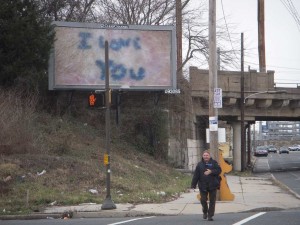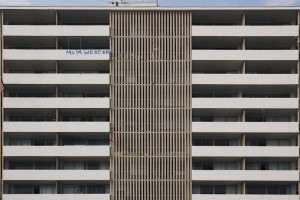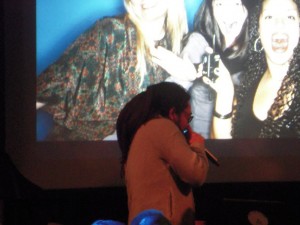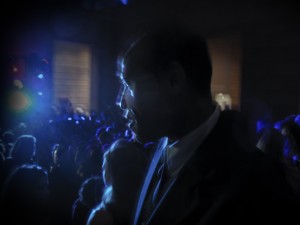[Note: This is a republish of a post that got lost in the transition to our new format.]
Billboards, dances, office hours, Megawords installation, the artist’s own blog–these may seem like the sideshow for Zoe Strauss’ photography exhibit, 10 Years, at the Philadelphia Museum of Art. But we think it is an integral part of the art itself. After all, Strauss conceived of her Under I-95 exhibits, which lasted 10 years, before she even owned a camera.
The photographs were a part of something bigger, part of a grand vision of uniting all the people of Philadelphia–especially the forgotten, the uneducated, the ones who never crossed the threshold of a gallery or art museum, the ones whose faces and scars, tats and bullet holes, boniness and fat are not part of the visual vocabulary of the culture or the way the culture prefers to represent itself.

The photographs were and are her GIFT to her neighborhood, her friends, her admirers, to Philadelphia, to the world, and not just to people who love art.
Under I-95, Strauss refused to charge big bucks for those photographs–$5 xerox copies was how she began selling them in 2000, and how she ended in 2010. Plus the digital print versions, the larger, higher-resolution versions, which she hung as the exhibition on the pillars under I-95, were FREE for the taking at the end of the one-day exhibit, and they, too, never got more expensive.
That these photographs of everyday Philadelphia people, some beautiful, some troubled, are hanging in the Philadelphia Museum of Art is not, for Strauss, about her photographs hanging there–although make no mistake she is thrilled. It’s that her people are hanging there. She did it. She inserted them into the record. Their lives matter because they lived and were loved, but now they matter to people who don’t really know them, as a part of art history.

But how many of those people will make it into the museum to admire themselves and their people? Some did on Saturday night, the night of the first dance party. For some of them you could tell museums were not their native habitat.
That’s where the 53 billboards come in. In all honesty, if we were choosing where to look at Zoe’s work, that’s the place. (By the way, the foursquare app lets you enter a contest based on seeing and sharing your photos of the billboards on twitter at #zscontest).
The billboards deliver the photographs in all their glory, ginormous, heroic, without frames or fancy mats. Strauss chose the pictures for the locations based on ideas and she imagines you will get those ideas. An oil spill picture is near a PECO plant. In the La Corona billboard, an Italian woman, to be succeeded two months later by a Mexican man, is on a South Philadelphia billboard, in a neighborhood occupied and transformed by Italians, only to be succeeded by later waves of immigrants, including most recently the Mexicans. These are her neighbors and her friends.

Best of all, the billboards are for people who might otherwise never cross the museum threshold, the ordinary people who work from dawn til way past dusk, who don’t have time to think about art, but who might wonder at why a beaming woman is up on a billboard instead of a pair of goth bimbos selling Pabst Blue Ribbon or a bag of Lay’s potato chips. The billboard art show is FREE to the public, the whole public.
Plus the billboards are word- and product-free, with no cartels or corporations pounding out the commercial messages, urging us all to consume the goods and the not-so-goods, whether we can afford them or not.

The events at the museum–Can you believe ?uestlove, David Dye, Cosmo Baker and Jerry Blavat spinning at multiple dance parties? 1800 people dancing on opening night? the Conestoga Drum Corps performing? Zoe available for conversation as she takes over museum Director Timothy Rub’s office for office hours. It all seems shocking in an institution that in many ways is dowdy and proper. But there’s method–even art–to the madness that is bringing in diverse crowds larger than the museum is used to handling.

During Saturday’s dance party, the guards were on crowd control duty. They looked a little stressed, and who could blame them. But the feel-good factor was off the charts and love was in the air as people posed for pictures that got inserted into slide shows of Strauss photos, which were flashing in several museum locations. The wine and beer came at a price, but the soft pretzels and mini-cupcakes were FREE, and true to Strauss’ own populist bent (she has been known to serve chewy Mary Jane candies and red Twizzlers) at her openings. Really! We wonder if anyone had ever served soft pretzels with mustard for a show at the PMA!
If you are not familiar with Strauss’ photographs, you owe it to yourself to see them. You can see nearly 150 of them on the gallery walls in the art museum. You can also look at them in several slide shows at the museum. You may be wondering about the night-time projections for MLK weekend that appeared on the front and back of the PMA–they also are of Strauss’ work.
But if you can get to the billboards, talks, office hours, dances and other programs, you will experience the core of the art and see the scale of the vision.
That all this happened is a result of Strauss’ enormous personal charm, which plays a major role in her art. She convinced people at the PMA it could get done. They got it done. She was convinced she could take noteworthy photographs before she owned a camera. She wants to change the world. She already has.









